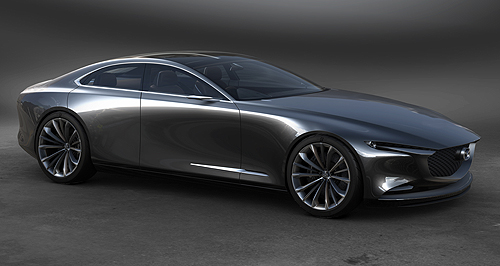Make / Model Search
News - MazdaTokyo show: Fresh Mazdas cast in new Kodo designStyle council: Mazda’s design language will evolve to be simpler and cleaner, with the Kai concept the latest example of this shift. New-generation Mazda models to wear ‘less is more’ updated Kodo design language25 Oct 2017 By TUNG NGUYEN in TOKYO MAZDA’S simplified and evolved Kodo design language seen in its Vision Coupe and Kai concepts unveiled in Tokyo this week – and its earlier RX-Vision show car – will be adapted to fit across the Japanese brand’s model range spanning passenger cars, SUVs, future electric vehicles and its next-generation BT-50 utility. Speaking at a design forum on the eve of the Tokyo motor show, Mazda Motor Corporation managing executive officer in charge of design and brand style Ikuo Maeda confirmed that the new design direction will spread throughout the brand’s product line-up. “In the coming generation of Mazda cars, we aim to express our own unique vision of elegance as part of this image,” Mr Maeda said. “Going forward … we plan to focus on showcasing the bodywork of our cars through an ever-changing interplay of light and shadow that glides over the surface as the viewing angle changes, creating cars that look truly alive.” The Kodo philosophy was first introduced in 2010 with the Shinari concept at that year’s Paris motor show and, at the time, laid the foundation for Mazda’s current model designs. The company now says that the evolution of the Kodo design previewed in the Vision Coupe concept will create “a look that is even more elegant than anything seen before, yet with the sense of vitality that characterises the Mazda style”. While the Vision Coupe and Kai concepts preview the look of the new-generation Mazda6 mid-size sedan and Mazda3 hatchback respectively, Mr Maeda told Australian journalists that the sleeker design philosophy is also being considered for the next BT-50. “Hopefully we can adapt this kind of design language onto a pick-up truck as well,” he said. “We have to focus on creating a beautiful form, but adding some ‘tough’ elements to it,” he said. Mr Maeda indicated that difficulties will likely arise from the use of Isuzu’s D-Max platform – switching from Ford Ranger underpinnings – instead of Mazda’s own, but he believes the evolution of the Kodo design could work on the one-tonne ute. Mazda Australia managing director Vinesh Bhindi also told GoAuto that, similarly, the simplified aesthetic – as well as the new SkyActiv vehicle architecture and compression-ignition SkyActiv-X engines – will carry over to Mazda’s SUV line-up when fresh models arrive. However, Mr Maeda hinted that the advanced Kodo design may not automatically sweep across the entire SUV range which includes the CX-3, (China-only) CX-4, CX-5, CX-8 and CX-9 models. “It depends on what kind of SUV, you know SUVs have spun in so many directions now,” he said. “We can adapt that design on SUV, only on particular SUVs I think.” Mr Maeda also indicated that if electrified vehicles do enter the Mazda stable, they will not stray too far away from the established Kodo theme despite the unique challenges in packaging batteries and electric motors. “I don’t want to use some unique different design language only for the EV,” he said. The updated Kodo design also heralds Mazda’s push into a refined and premium aesthetic without pushing the brand too far upmarket, according to Mr Maeda. “I have to say yes, but I don’t want to say like luxury,” he said. “Premium. We’re going to have a lot of choices, other directions, but high quality and nice design … but not luxury, this is not the direction we have to pursue I think. “Still we have to produce (vehicles) a little bit (more) affordable than the really high-end premium brands.” Mr Bhindi echoed that Mazda products would not move upstream to compete against the likes of Lexus or Infiniti. “Sometimes people think premium is automatically price-driven,” he said. “It’s not about the price equation, what it is about is premium design. “Price and design should not be looked at in isolation,” he added, pointing to engine performance, in-cabin technology and specification as better indicators of overall cost.  Read more11th of October 2017  Tokyo show: Mazda teases two conceptsShades of next Mazda3 in SkyActiv-X hatchback concept destined for Tokyo show11th of September 2017  Bumpy road to Mazda compression-ignition petrol unitMultiple problems kept Mazda’s boffins busy for years before the system worked10th of September 2017  Mazda ‘SkyActiv-X’ to run alongside current enginesNew blown compression-ignition engines to sell alongside current powertrains: Mazda |
Click to shareMotor industry news |











Facebook Twitter Instagram